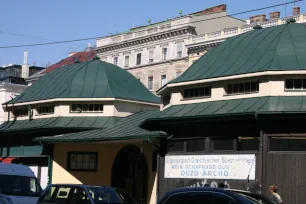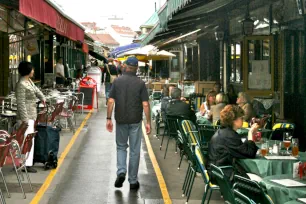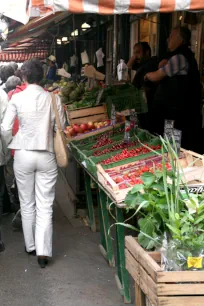There are many outdoor markets in Vienna, but the Naschmarkt is the oldest and most notable. You’ll find all sorts of stalls here selling flowers, wine, food and much more. Nearby are some fine examples of Jugendstil architecture.
History


In existence since the sixteenth century, Vienna’s Naschmarkt has always been one of the most popular farmer’s markets in the city. The name of the market, some say, comes from the fact that the market was originally a milk market. The buckets for the milk were made from the ash tree (esch in German). The bottles were referred to as asch and the market began to be referred to as the Aschenmarkt, eventually morphing into its current name. According to others, the name simply stems from a German word for eating sweets (naschen).
Regardless of how the name came about, however, there is no disputing that Naschmarkt attracts thousands of visitors each day. The location where it sits was once the riverbed of a branch of the Danube, paved over sometime during the mid-nineteenth century.
Today, recently harvested fruits and vegetables dominate the hundreds of stands here. Visitors will also find droves of merchants selling vast varieties of spices, especially those from the Middle East. There are also quite a few butcher shops, and in the center, browsers will find many stalls peddling housewares as well.


International Flavor
In recent years, Naschmarkt has taken on a decidedly international flavor, and it’s not unusual to hear many languages spoken there. In particular, there has been a strong influx of Turkish merchants at the market, offering a variety of delights from their country. A strong Asian presence is also found at this expansive open-air market, and it’s common to see lots of sushi stands and those selling other Chinese, Japanese, Korean, or Vietnamese favorites. That’s not to say, of course, that you can’t find good Viennese food here as well. Sausages, schnitzel, and other local dishes can be enjoyed at several stalls or restaurants at the market, and there’s plenty of beer to go with it.
Jugendstil
Near the Naschmarkt are a couple of interesting examples of Jugendstil architecture, the local version of Art Nouveau. At the Linke Wienzeile nos. 38 and 40, near the Köstlergasse are two Jugendstil buildings designed by Otto Wagner. The Majolikahaus at no. 40 is decorated with flower motifs.
At the other end of the Naschmarkt, near Karlsplatz, is the Secession Building, possibly Vienna’s most famous example of Jugendstil architecture. It was built at the end of the nineteenth century after a design by Joseph Maria Olbrich for the Secession movement, a group of artists who revolted against the conservative art establishment.

